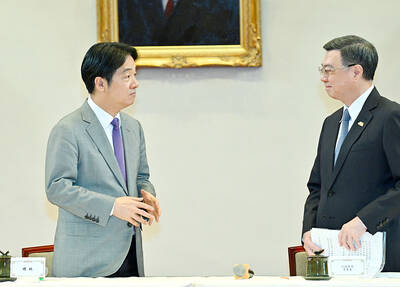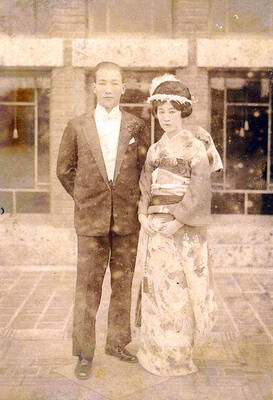Carlos Bousted is a laid-back recent high school graduate and a sometime DJ. Unlike most DJs, though, Bousted does not have to lug around crates of records, CDs or even an iPod. His music is strictly cellular.
Bousted, 18, is a ringtone DJ. A competitive ringtone DJ. "You put certain songs in order and play them against other people," he said, explaining his technique. "Anytime you're walking around: `Oh, what you got?' And then you pull out your phone."
Downloadable ringtones like the ones Bousted uses -- tunes from artists like the Yin Yang Twins and 50 Cent -- have been a teenage mainstay for years, a mushrooming market worth almost US$5 billion globally (the US share is US$600 million and growing).

But as people like Bousted have grown fluent in the language of ringtones, industry executives and musicians alike have realized that they need not be duplicates of already popular songs; there is room for creativity alongside the commerce.
"We definitely see a market for original content," said Andy Volanakis, president and chief officer of Zingy, a ringtone provider that has released an album by the producer Timbaland.
When combined with technology that allows them to sound like music instead of its tinny shadow, and programs that allow anyone to make, mix or otherwise devise his or her own ringtones, the seven songs on the Timbaland album -- among the first meant to be played on a phone, not a radio or CD player -- suggest that ring tones are not merely a new money-maker; they are a new art form.
"People have really started to take this stuff seriously," said Jonathan Dworkin, vice president for artists and repertory at BlingTones, a Zingy competitor that was one of the first to focus on original works. Its partners include the crunk progenitor Lil Jon, Q-Tip, and others.
With ringbacks, voice tones (Snoop Dogg says, "Pick up the phone!") and sound effects crowding the field, there are more opportunities to circumvent the cellphone's bleep or brring than ever before. Even Nokia, which in 1991 became the first company to market a cellphone with an identifiable musical ring tone (Francisco Tarrega's Gran Vals for classical guitar), has moved away from its traditional tunes. For its newest phone, the Nokia 8801, it commissioned wholly original music and sounds, composed exclusively for cellphone by the eclectic Japanese composer Ryuichi Sakamoto. Later this summer, Zingy will release a song by Free Murda, a Wu-Tang Clan acolyte, as both a single and a ringtone; it was produced by RZA, who compiled the scores for Quentin Tarantino's Kill Bill films.
Why would a serious musician bother? After all, a song can have multiple lives; a ringtone, just one, and a fruit-fly-length one at that. (Timbaland's seven original ringtones average just 20 seconds each.) Money is definitely one reason. As Lil Jon said of BlingTones, "They cut the check." But that's not the end of the story. "It's another way of reaching your audience," he added in a telephone interview. "It's exciting. Like, I was already thinking, what if I produce a song for the cellphone that ends up getting on music charts? The technology is so crazy, that could one day happen."
Actually, it already has: in Britain, the heavily advertised Crazy Frog ringtone -- based on a Swedish teenager's imitation of a revving engine -- topped artists like Coldplay and U2 on the singles charts just last month. And the remix is already out.
One BlingTones artist, Tony Kelly, has already started incorporating the old standard-issue cellphone rings into his new ringtones -- a postmodern remix in which the Nokia song morphs into a hip-hop beat, for example.
Mainstream musicians are not the only ones intrigued by the possibility of the ringing opus. In 2001, the multimedia artist Golan Levin, now a professor of electronic art at Carnegie Mellon University in Pittsburgh, was the co-creator of Dialtones, a "telesymphony" (flong.com/telesymphony), composed entirely of the rings of audience members' cellphones. In Britain (where pop-inspired ringtones already often outsell the songs they are based on), there's a wide variety of phone art, from Nick Crowe's Axis of Evil national anthems (artones.net) to Stream and Shout, which paired artists and students to create original ringtones (streamandshout.net).
"They understood it immediately," Ross Dalziel, a Liverpool, England, sound artist, said of the teenagers he worked with on the Stream and Shout project. For many people, especially the young, ringtones are as musically viable as a favorite mixtape was a generation ago. "The phone playing their favorite song is their identifier," said Geoff Mayfield, director of charts and senior analyst at Billboard magazine, which began a ringtone chart last fall. "That's part of how they brand themselves," he added.
Like so much technology before it, then, the cellphone has morphed far beyond its original function. "A phone used to ring just to get your attention," Levin said. Now, said Patrick Parodi, chairman of Mobile Entertainment Forum, a London-based trade association, "It's probably the device that identifies us most, along with our cars." For musicians, the ringtone also presents an irresistible opportunity to connect with fans. Customization is growing daily: consumers can now choose what part of Fabolous' single Baby they want as their ringtone; previously, record companies made those kinds of decisions.
"The direction we're going in is you'd actually have this artist create the ringtone when your boyfriend calls, or your best friend," said Amy Doyle, vice president for music programming at MTV, which helped release the Timbaland album. "So it becomes the artist scoring your life, almost, on your cellphone." According to Edward Bilous, a professor at the Juilliard School, "Ringtones are pointing towards a kind of new interactive media in which the user and the creator have a more democratic relationship with each other."
But as every sidewalk, cafe, or mode of public transport by now proves, there's also a performance aspect to mobile phones. (After all, nobody customizes the ringtone on a home phone.) And not everyone regards it as welcome. "I think most people would agree with me that as they exist now, ringtones are a public nuisance," Sakamoto wrote in an e-mail message. (Presumably, his composition for Nokia is an exception.)
There are certainly limitations to the form, though Levin suggests that boundaries breed creativity. But with sales on the rise, companies like Verizon, Cingular, and Sprint are creating music-playing phones and giving them the ability to tune in streaming radio. And while Bilous worries that the ubiquity of musical cellphones might ruin the listening experience (he is already pondering starting a course called "From Ring Cycle to Ringtones: A Study in Musical Attention Deficit Disorder"), others contend that they can create new fans with every sound. Even the ringtone battles described by Bousted, the cellphone DJ, foster community.
"You have a little group of people and they'll decide, like, `Oh, yours is better,"' he said. "And then you talk to each other and make friends."
Levin added, "It can be a vehicle for creative expression both on the part of the composer and the part of the person who uses it. The ringtone has a clear connection to everyday life, and, because of that, I think it's a vital form." For those who disagree, there's always vibrate.

Under pressure, President William Lai (賴清德) has enacted his first cabinet reshuffle. Whether it will be enough to staunch the bleeding remains to be seen. Cabinet members in the Executive Yuan almost always end up as sacrificial lambs, especially those appointed early in a president’s term. When presidents are under pressure, the cabinet is reshuffled. This is not unique to any party or president; this is the custom. This is the case in many democracies, especially parliamentary ones. In Taiwan, constitutionally the president presides over the heads of the five branches of government, each of which is confusingly translated as “president”

Sept. 1 to Sept. 7 In 1899, Kozaburo Hirai became the first documented Japanese to wed a Taiwanese under colonial rule. The soldier was partly motivated by the government’s policy of assimilating the Taiwanese population through intermarriage. While his friends and family disapproved and even mocked him, the marriage endured. By 1930, when his story appeared in Tales of Virtuous Deeds in Taiwan, Hirai had settled in his wife’s rural Changhua hometown, farming the land and integrating into local society. Similarly, Aiko Fujii, who married into the prominent Wufeng Lin Family (霧峰林家) in 1927, quickly learned Hoklo (commonly known as Taiwanese) and

The Venice Film Festival kicked off with the world premiere of Paolo Sorrentino’s La Grazia Wednesday night on the Lido. The opening ceremony of the festival also saw Francis Ford Coppola presenting filmmaker Werner Herzog with a lifetime achievement prize. The 82nd edition of the glamorous international film festival is playing host to many Hollywood stars, including George Clooney, Julia Roberts and Dwayne Johnson, and famed auteurs, from Guillermo del Toro to Kathryn Bigelow, who all have films debuting over the next 10 days. The conflict in Gaza has also already been an everpresent topic both outside the festival’s walls, where

The low voter turnout for the referendum on Aug. 23 shows that many Taiwanese are apathetic about nuclear energy, but there are long-term energy stakes involved that the public needs to grasp Taiwan faces an energy trilemma: soaring AI-driven demand, pressure to cut carbon and reliance on fragile fuel imports. But the nuclear referendum on Aug. 23 showed how little this registered with voters, many of whom neither see the long game nor grasp the stakes. Volunteer referendum worker Vivian Chen (陳薇安) put it bluntly: “I’ve seen many people asking what they’re voting for when they arrive to vote. They cast their vote without even doing any research.” Imagine Taiwanese voters invited to a poker table. The bet looked simple — yes or no — yet most never showed. More than two-thirds of those